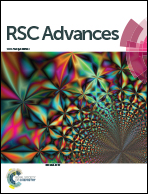Optical, dielectric & ferroelectric studies on amino acids doped TGS single crystals
Abstract
Pure TGS and amino acids (L-arginine, L-histidine and L-alanine) doped TGS crystals were grown by slow evaporation solution growth technique at room temperature. The optical transmission window and optical band gap of the crystals were found by UV-Vis studies. The cut off wavelengths of the grown crystals were observed between 220 nm and 290 nm. The dielectric behaviour was investigated at different frequencies and temperatures. AC conductivity was determined. Photoconductivity study reveals that the grown crystals exhibit negative photoconductivity. The ferroelectric nature of the crystals was identified by P–E hysteresis loop analysis. The piezoelectric d33 coefficient has been measured for the doped TGS crystals. Two close emission bands in the luminescence spectra in the near UV region reveal their application in developing new coherent sources of radiation in this region. Among the three dopants, L-arginine doped TGS possesses low dielectric constant and high piezo electric coefficient, suggesting that this can be a potential material for infrared detectors.


 Please wait while we load your content...
Please wait while we load your content...